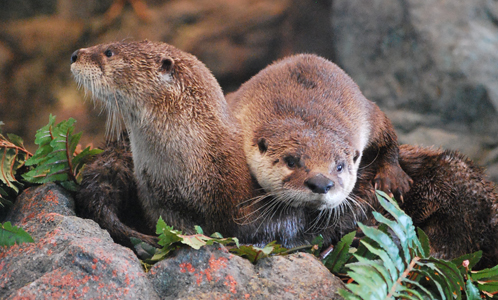It seems that river otters are all the rage these days. First, Sutro Sam made his debut at the Sutro baths, drawing in fans from all over to observe his daily antics.

Aquarium of the Bay’s new river otter resident, Wildcat, takes a dip in one of the multiple pools located in the exhibit space constructed specifically for the otters. Photo by Kevin Comora
By Mallory Johnson
Published: July, 2013
It seems that river otters are all the rage these days. First, Sutro Sam made his debut at the Sutro baths, drawing in fans from all over to observe his daily antics. Then, Aquarium of the Bay’s new North American river otter exhibit opened last month with much fanfare. The public was introduced to the aquarium’s newest members, Shasta, Tubbs and Wildcat, giving Sutro Sam some competition for San Francisco’s favorite river otter.
While there are so many wonderful things to know about river otters, one of the common questions people ask is what it’s like to work one-on-one with these endearing animals. Melissa Schouest and Annie Brethour, otter biologists at Aquarium of the Bay, are here to describe their experiences.
What is your role working with the otters at Aquarium of the Bay?
Melissa: To put it simply, we perform day-to-day care for our otters. This includes everything from feeding them, cleaning up after them and running training programs with them. We also run extensive behavioral enrichment programs with them, because behavioral and mental care is just as important as keeping the otters physically healthy. It’s up to us to keep them mentally engaged and stimulated. We give them puzzles and toys to play with, make sure they get plenty of opportunities to be active, and we even keep them on a variable schedule. It’s a lot of work, because you constantly have to change it up to keep them stimulated.
What is your favorite thing about otters?
Annie: I think it’s amazing how well they’re able to function in different environments. They’re incredible hunters on land and in the water, and it’s truly amazing to watch them move between the two and adapt to different surroundings.
Melissa: I love how relaxed they are. We have hammocks for them behind-the-scenes, which they love. I could watch them groom and swing in their hammocks all day.
What is your favorite thing about working with otters?
Melissa: Otters are extremely intelligent animals. Working with them requires you to constantly analyze what you’re doing and make adjustments. They like to see what they can get away with. They are very motivated animals that need lots of stimulation, which really allows for great training opportunities.
Annie: I love how quickly they pick up new concepts. They are really fun to work with because you can see when they start to understand what you are asking them to do, and then they try-and sometimes succeed-in out-smarting you. They really are quite clever.
What is an important thing you think people should know about river otters?
Annie: A lot of people tend to confuse river otters for sea otters, when in fact they are quite different. For example, river otters are not considered marine mammals. They live in fresh water and actually spend the majority of their time on land, unlike sea otters which live in salt water and spend most of their time in the water. This seems to be the most common mistake that people make when I talk about the otters at Aquarium of the Bay.
What aspect of Aquarium of the Bay’s new river otter exhibit are you most excited about?
Annie: I think that river otters will be the perfect teachers about the importance of the watershed. They are really fun to watch, and there is so much to learn from them. I’m really excited about the opportunity that the river otters will create for our guests to learn about their environment.
Melissa: I agree. I think this new exhibit will really create a unique connection between our visitors and their impact on the environment. After coming nose-to-nose with an otter, you just can’t help but to take pause and reflect on what you can change in your life to help these animals thrive.
What is your favorite feature of the new exhibit?
Melissa: We’ve taken great care to replicate the natural habitat of river otters and I’m really proud of some of the features that were included in the new exhibit. There are quite a few substrate areas for the otters to play and groom in, such as sand, gravel, dirt and hay to change it up and keep it fresh. We might even be able to give them some ice or snow some days. River otters love snow. The exhibit also has live fish in the pools and live plants throughout, which I think is a really nice touch for the otters.
Annie: I love how dynamic the exhibit is. The otters have multiple pools to swim in, rocks and trees to climb, and pits to dig in. It’s great to watch them explore the exhibit and see how they utilize all the different aspects of it.
To learn more about Shasta, Tubbs and Wildcat, visit aquariumofthebay.org, or visit them in person at Aquarium of the Bay on PIER 39.

The new river otters can often be found cuddling together. Here, Shasta and Wildcat are seen lounging together with a slight interest in the many observers peering into their new surroundings. Photo by Joel Williams

Aquarium of the Bay Otter Biologists, Melissa Schouest (left) and Annie Brethour.

